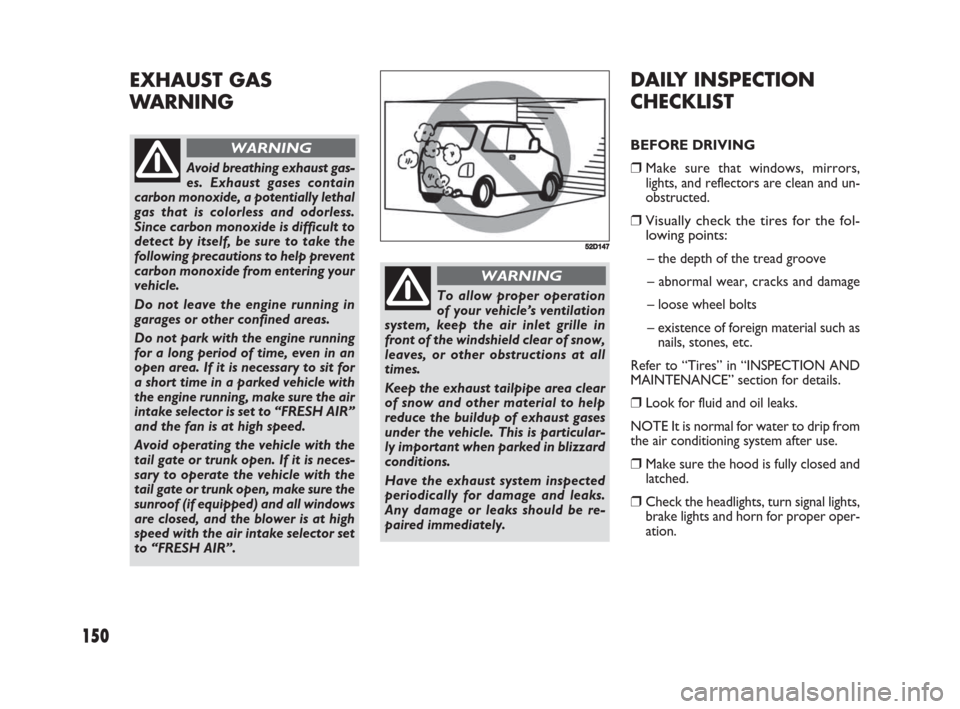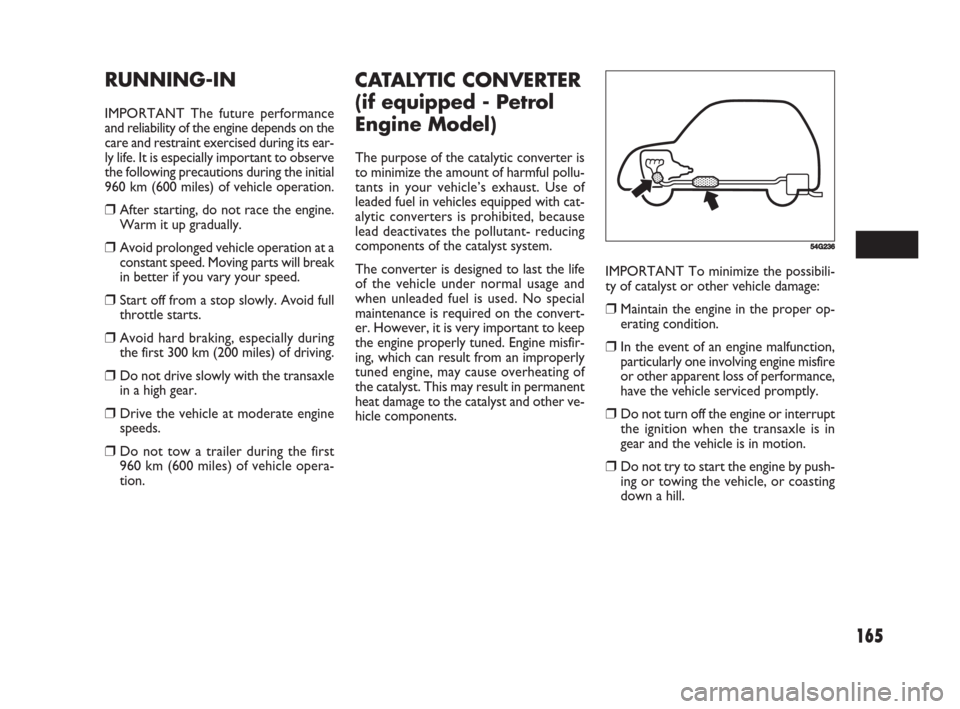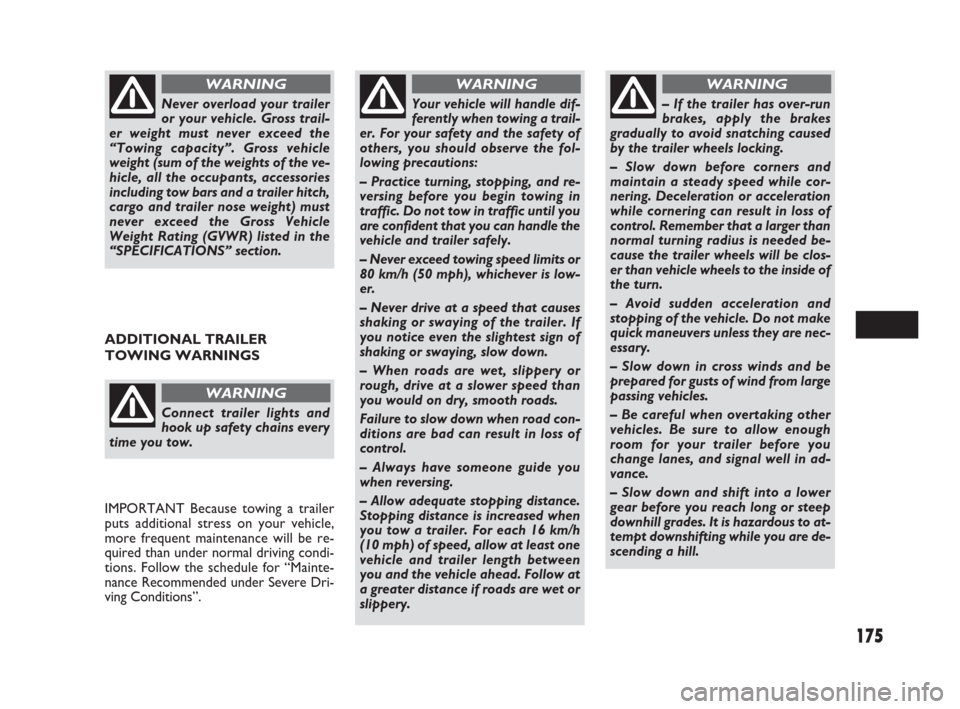2008 FIAT SEDICI maintenance
[x] Cancel search: maintenancePage 151 of 266

150
DAILY INSPECTION
CHECKLIST
BEFORE DRIVING
❒Make sure that windows, mirrors,
lights, and reflectors are clean and un-
obstructed.
❒Visually check the tires for the fol-
lowing points:
– the depth of the tread groove
– abnormal wear, cracks and damage
– loose wheel bolts
– existence of foreign material such as
nails, stones, etc.
Refer to “Tires” in “INSPECTION AND
MAINTENANCE” section for details.
❒Look for fluid and oil leaks.
NOTE It is normal for water to drip from
the air conditioning system after use.
❒Make sure the hood is fully closed and
latched.
❒Check the headlights, turn signal lights,
brake lights and horn for proper oper-
ation.
EXHAUST GAS
WARNING
52D147
Avoid breathing exhaust gas-
es. Exhaust gases contain
carbon monoxide, a potentially lethal
gas that is colorless and odorless.
Since carbon monoxide is difficult to
detect by itself, be sure to take the
following precautions to help prevent
carbon monoxide from entering your
vehicle.
Do not leave the engine running in
garages or other confined areas.
Do not park with the engine running
for a long period of time, even in an
open area. If it is necessary to sit for
a short time in a parked vehicle with
the engine running, make sure the air
intake selector is set to “FRESH AIR”
and the fan is at high speed.
Avoid operating the vehicle with the
tail gate or trunk open. If it is neces-
sary to operate the vehicle with the
tail gate or trunk open, make sure the
sunroof (if equipped) and all windows
are closed, and the blower is at high
speed with the air intake selector set
to “FRESH AIR”.
WARNING
To allow proper operation
of your vehicle’s ventilation
system, keep the air inlet grille in
front of the windshield clear of snow,
leaves, or other obstructions at all
times.
Keep the exhaust tailpipe area clear
of snow and other material to help
reduce the buildup of exhaust gases
under the vehicle. This is particular-
ly important when parked in blizzard
conditions.
Have the exhaust system inspected
periodically for damage and leaks.
Any damage or leaks should be re-
paired immediately.
WARNING
149-166 Fiat16 New GB 3-09-2008 8:15 Pagina 150
Page 152 of 266

151
Once a week, or each time you fill your
fuel tank, perform the following under-
hood checks:
❒Engine oil level
❒Coolant level
❒Brake fluid level
❒Power steering (if equipped) fluid level
❒Windshield washer fluid level
❒Battery solution level
❒Hood latch operation
Pull the hood release handle inside the
vehicle. Make sure that you cannot
open the hood all the way without re-
leasing the secondary latch. Be sure to
close the hood securely after check-
ing for proper latch operation. See “All
latches, hinges & locks” of “CHASSIS
AND BODY” in the “Periodic Main-
tenance Schedule” in the “INSPEC-
TION AND MAINTENANCE” section
for lubrication schedule.Once a month, or each time you fill your
fuel tank, check the tire pressure using a
tire pressure gauge. Also check the tire
pressure of the spare tire.❒Adjust the seat and adjustable head re-
straint (if equipped).
❒Check the brake pedal and the park-
ing brake lever.
❒Adjust the mirrors.
❒Make sure that you and all passengers
have properly fastened your seat belts.
❒Make sure that all warning lights come
on as the key is turned to the “ON” or
“START” position.
❒Check all gauges.
❒Make sure that the BRAKE SYSTEM
WARNING light turns off when the
parking brake is released.
60A187S
Make sure the hood is fully
closed and latched before
driving. If it is not, it can fly up un-
expectedly during driving, obstructing
your view and resulting in an acci-
dent.
WARNING
149-166 Fiat16 New GB 3-09-2008 8:15 Pagina 151
Page 160 of 266

159
IMPORTANT
❒Never use the “4WD LOCK” mode
when driving on dry paved roads.
Avoid using the “4WD LOCK” mode
when driving on wet paved roads as
much as possible. Use of the “4WD
LOCK” mode in above conditions will
apply excessive force to the driving
system and may cause a critical failure.
Also, the tires may wear faster and fu-
el consumption may be affected ad-
versely.
❒Note that 4WD vehicles are not al-
laround vehicles. Be sure to observe
following instructions when driving
your vehicle.
– Do not drive through water like
crossing a river.
– Do not drive continuously where
front wheels tend to race such as in
the sand and mud.
– When any wheel is in the air for such
reason as running off the road, do
not race it needlessly.
❒If the “4WD AUTO” and the “4WD
LOCK” indicator lights stay on and
come on simultaneously when driving,
there may be something wrong the
4WD system. Have the system in-
spected by an authorized Fiat Dealer-
ship.IMPORTANT Unevenly worn tires can
cause problems in the operation of the
2WD/4WD switch. Be sure to rotate the
tires according to the maintenance sched-
ule. Refer to “Tires” and “Maintenance
Schedule” in the “INSPECTION AND
MAINTENANCE” section for proper tire
rotation procedures.
❒While making turns or accelerating and
decelerating, operating the 2WD/
4WD switch or turning off the key
switch in the “4WD AUTO” or “4WD
LOCK” mode may cause a shock, but
this is not a system malfunction.
❒While driving in the “4WD LOCK”
mode, as the vehicle speed increases,
the driving mode changes to the “4WD
AUTO” mode automatically. Even
when the vehicle speed reduces, on the
other hand, the driving mode does not
return to the “4WD LOCK” mode au-
tomatically. You should press the
“4WD LOCK” switch according to the
driving conditions.
❒Any forcible operation while driving of-
froad in the sand or water or when a
wheel has run off the road, the differ-
ence of the revolution between front
wheels and rear wheels increases
(wheels run idle). If this state continues,
the oil temperature of the driving sys-
tem parts rises.
In such case, the “4WD AUTO” indi-
cator light blinks and the driving mode
changes to the 2WD mode to protect
the driving system parts.
When you operate your vehicle in the
4WD mode continuously, park the ve-
hicle at a safe place and run the engine
idle. After some time, the “4WD AU-
TO” indicator light turns on again and
the driving mode returns to the “4WD
AUTO” mode.
149-166 Fiat16 New GB 3-09-2008 8:15 Pagina 159
Page 166 of 266

165
IMPORTANT To minimize the possibili-
ty of catalyst or other vehicle damage:
❒Maintain the engine in the proper op-
erating condition.
❒In the event of an engine malfunction,
particularly one involving engine misfire
or other apparent loss of performance,
have the vehicle serviced promptly.
❒Do not turn off the engine or interrupt
the ignition when the transaxle is in
gear and the vehicle is in motion.
❒Do not try to start the engine by push-
ing or towing the vehicle, or coasting
down a hill.
CATALYTIC CONVERTER
(if equipped - Petrol
Engine Model)
The purpose of the catalytic converter is
to minimize the amount of harmful pollu-
tants in your vehicle’s exhaust. Use of
leaded fuel in vehicles equipped with cat-
alytic converters is prohibited, because
lead deactivates the pollutant- reducing
components of the catalyst system.
The converter is designed to last the life
of the vehicle under normal usage and
when unleaded fuel is used. No special
maintenance is required on the convert-
er. However, it is very important to keep
the engine properly tuned. Engine misfir-
ing, which can result from an improperly
tuned engine, may cause overheating of
the catalyst. This may result in permanent
heat damage to the catalyst and other ve-
hicle components.
54G236
RUNNING-IN
IMPORTANT The future performance
and reliability of the engine depends on the
care and restraint exercised during its ear-
ly life. It is especially important to observe
the following precautions during the initial
960 km (600 miles) of vehicle operation.
❒After starting, do not race the engine.
Warm it up gradually.
❒Avoid prolonged vehicle operation at a
constant speed. Moving parts will break
in better if you vary your speed.
❒Start off from a stop slowly. Avoid full
throttle starts.
❒Avoid hard braking, especially during
the first 300 km (200 miles) of driving.
❒Do not drive slowly with the transaxle
in a high gear.
❒Drive the vehicle at moderate engine
speeds.
❒Do not tow a trailer during the first
960 km (600 miles) of vehicle opera-
tion.
149-166 Fiat16 New GB 3-09-2008 8:15 Pagina 165
Page 176 of 266

175
ADDITIONAL TRAILER
TOWING WARNINGS
Never overload your trailer
or your vehicle. Gross trail-
er weight must never exceed the
“Towing capacity”. Gross vehicle
weight (sum of the weights of the ve-
hicle, all the occupants, accessories
including tow bars and a trailer hitch,
cargo and trailer nose weight) must
never exceed the Gross Vehicle
Weight Rating (GVWR) listed in the
“SPECIFICATIONS” section.
WARNING
Connect trailer lights and
hook up safety chains every
time you tow.
WARNING
IMPORTANT Because towing a trailer
puts additional stress on your vehicle,
more frequent maintenance will be re-
quired than under normal driving condi-
tions. Follow the schedule for “Mainte-
nance Recommended under Severe Dri-
ving Conditions”.
Your vehicle will handle dif-
ferently when towing a trail-
er. For your safety and the safety of
others, you should observe the fol-
lowing precautions:
– Practice turning, stopping, and re-
versing before you begin towing in
traffic. Do not tow in traffic until you
are confident that you can handle the
vehicle and trailer safely.
– Never exceed towing speed limits or
80 km/h (50 mph), whichever is low-
er.
– Never drive at a speed that causes
shaking or swaying of the trailer. If
you notice even the slightest sign of
shaking or swaying, slow down.
– When roads are wet, slippery or
rough, drive at a slower speed than
you would on dry, smooth roads.
Failure to slow down when road con-
ditions are bad can result in loss of
control.
– Always have someone guide you
when reversing.
– Allow adequate stopping distance.
Stopping distance is increased when
you tow a trailer. For each 16 km/h
(10 mph) of speed, allow at least one
vehicle and trailer length between
you and the vehicle ahead. Follow at
a greater distance if roads are wet or
slippery.
WARNING
– If the trailer has over-run
brakes, apply the brakes
gradually to avoid snatching caused
by the trailer wheels locking.
– Slow down before corners and
maintain a steady speed while cor-
nering. Deceleration or acceleration
while cornering can result in loss of
control. Remember that a larger than
normal turning radius is needed be-
cause the trailer wheels will be clos-
er than vehicle wheels to the inside of
the turn.
– Avoid sudden acceleration and
stopping of the vehicle. Do not make
quick maneuvers unless they are nec-
essary.
– Slow down in cross winds and be
prepared for gusts of wind from large
passing vehicles.
– Be careful when overtaking other
vehicles. Be sure to allow enough
room for your trailer before you
change lanes, and signal well in ad-
vance.
– Slow down and shift into a lower
gear before you reach long or steep
downhill grades. It is hazardous to at-
tempt downshifting while you are de-
scending a hill.
WARNING
171-180 Fiat16 New GB 3-09-2008 8:42 Pagina 175
Page 182 of 266

181
I I
N N
S S
P P
E E
C C
T T
I I
O O
N N
A A
N N
D D
M M
A A
I I
N N
T T
E E
N N
A A
N N
C C
E E E
60G410
MAINTENANCE SCHEDULE ........................................... 183
MAINTENANCE RECOMMENDED UNDER SEVERE
DRIVING CONDITIONS .................................................... 188
DRIVE BELT .......................................................................... 189
ENGINE OIL AND FILTER ................................................ 189
GEAR OIL .............................................................................. 193
ENGINE COOLANT .......................................................... 195
WINDSHIELD WASHER FLUID ...................................... 198
AIR CLEANER ...................................................................... 198
SPARK PLUGS (Petrol engine).......................................... 199
FUEL FILTER (Diesel engine)............................................. 201
BRAKES .................................................................................. 202
STEERING .............................................................................. 204
CLUTCH PEDAL ................................................................. 205
TIRES ....................................................................................... 205
BATTERY ............................................................................... 210
FUSES ...................................................................................... 212
BULB REPLACEMENT ........................................................ 218
WINDSCREEN - REAR WINDOW WASHER /
WIPERS .................................................................................. 223
AIR CONDITIONING SYSTEM ....................................... 224
8
181-224 Fiat16 New GB 3-09-2008 8:17 Pagina 181
Page 184 of 266

183
IMPORTANT Whenever it becomes nec-
essary to replace parts on your vehicle,
it is recommended that you use genuine
Fiat replacement parts.
MAINTENANCE
SCHEDULE
The following table shows the times when
you should perform regular maintenance
on your vehicle. This table shows in miles,
kilometers and months when you should
perform inspections, adjustments, lubri-
cation and other services. These intervals
should be shortened if driving is usually
done under severe conditions (refer to
“Maintenance Recommended under Se-
vere Driving Conditions”).
IMPORTANT The Programmed Mainte-
nance coupons are specified by the Man-
ufacturer. The failure to have them car-
ried out may invalidate the warranty.
79J004
Vehicle maintenance should
be entrusted to Fiat Dealer-
ship. For routine and minor mainte-
nance operations you wish to carry
out yourself, always make sure you
have the proper equipment, genuine
Fiat spare parts and the necessary flu-
ids; do not however carry out these
operations if you have no experience.
WARNING
54G088
(1) Oxygen sensor
The shock absorbers are
filled with high pressure gas.
Never attempt to disassemble it or
throw it into a fire. Avoid storing it
near a heater or heating device.
When scrapping the absorber, the gas
must be released from the absorber
safely. Ask your Fiat Dealershipfor as-
sistance.
WARNING
181-224 Fiat16 New GB 3-09-2008 8:17 Pagina 183
Page 189 of 266

188
RReplace or Change
IInspect and correct or replace if necessary
LLubricate Severe condition code
ARepeated short trips
BDriving on rough and/or muddy roads
CDriving on dusty roads
DDriving in extremely cold weather and/ or salted roads
ERepeated short trips in extremely cold weather
FLeaded fuel use
HTrailer towing (if admitted)
MAINTENANCE RECOMMENDED UNDER SEVERE DRIVING CONDITIONS
If the vehicle is usually used under the conditions corresponding to any severe condition code given below, it is recommended that
applicable maintenance operation be performed at the particular interval as given in the chart below.
Severe Condition Code
B C D
AD
A C D E F H
A C D E H
A B C E F H
C
B C D H
B D E H
B E H
Maintenance Interval
Every 15,000 km (9,000 miles) or 12 months
Every 45,000 km (27,000 miles) or 36 months
Every 48 months
Every 7,500 km (4,500 miles) or 6 months
Every 7,500 km (4,500 miles) or 6 months
Every 30,000 km (18,000 miles) or 24 months
Every 10,000 km (6,000 miles) or 8 months
Every 30,000 km (18,000 miles) or 24 months
Every 15,000 km (9,000 miles) or 12 months
Every 15,000 km (9,000 miles) or 12 months
First time only: 15,000 km (9,000 miles) or
12 months
Second time and after: Every 30,000 km
(18,000 miles) or 24 months reckoning from
0 km (0 mile) or 0 month Maintenance
Accessory drive belt (V-belt)
Timing belt (Diesel versions)
Engine oil and oil filter (Petrol versions)
Engine oil and oil filter (Diesel versions)
Spark plugs
Air cleaner cartridge
(Check and replace more frequently, if required)
Wheel bearings
Driving axle /Propeller shaft casing (4WD)
Manual transaxle gear oil
Transmission unit oil (4WD)
Differential oil (4WD)Maintenance
Operation
I
R
R
R
R
R
R
R
I
I
R Iridium plugs (recommended)
Nickel plugs (traditional)
181-224 Fiat16 New GB 3-09-2008 8:17 Pagina 188